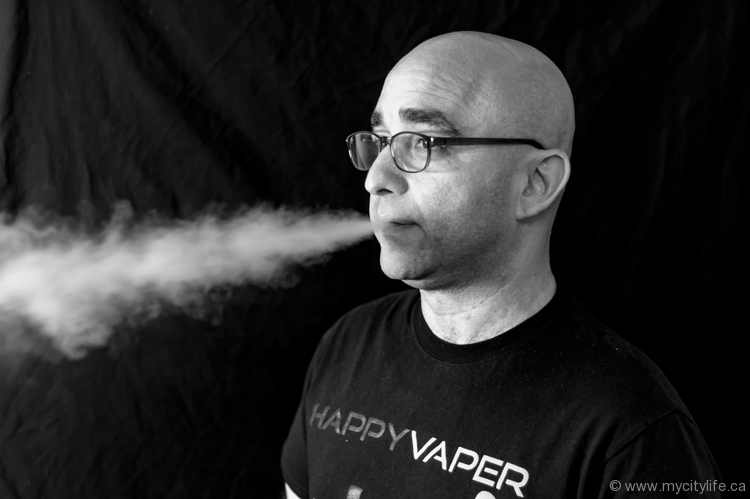E-CIGARETTES – CHASING THE CLOUDS AWAY
City Life Magazine weighs in on the Electronic Cigarettes Act coming into effect in the new year.
Vaper Jack Weinberg pulls an e-cigarette device from his pocket and casually takes a pull. With each discreet drag of the high-tech gadget, a thin stream of vapour is emitted, quickly dissipating into the air and leaving behind the scent of caramel candy. He calls the technique “stealth vaping,” a sharp contrast to the billowing white plumes forming an impenetrable wall in the foyer of his Concord, Ont., vape shop. Weinberg refers to his counterparts as “cloud chasers” — vapers who prefer to revel in the spectacle of a big and cloudy show.
Sitting in Weinberg’s back office, our interview starts off unconventionally, to say the least, but it’s reflective of the growing number of people choosing to vape in an attempt to avoid the death sentence linked to tobacco and cigarettes. And while sales of e-cigarettes continue to rise, so have concerns over their possible health risks.
E-cigarettes, for the uninitiated, are battery-powered contraptions that contain an atomizer and refillable tank where e-liquid, a.k.a. “e-juice,” is stored. Puffing on the tobacco-free device like you would a cigarette heats up the liquid and produces a vapour that imitates the experience of lighting up a conventional cigarette. Bottles of e-juice may or may not contain up to 18 milligrams of nicotine, depending on the needs of the user. Flashy and modern, e-cig gadgets are available in a variety of colours and sizes that fit in the grip of your hand and jut out with a metal, cylindrical mouthpiece. New-generation devices are much more technologically sophisticated in terms of battery life and boast advanced features like temperature control.
Earlier this year the Ontario government passed Bill 45, the Making Healthier Choices Act, which includes directives aimed at protecting youth from the dangers of tobacco and potential harms of e-cigarettes. As of Jan. 1, 2016, the new law will prohibit the sale and supply of e-cigarettes to those under the age of 19 and ban their use in designated non-smoking areas across Ontario. “All the places where most of us have grown up in the last decade expecting to be smoke-free are now going to be vape-free as well,” says Vito Chiefari, manager of health protection at York Region. To clear the air even further: the around 160 vape lounges in the Greater Toronto Area — where customers go to performance-test e-cigarette devices and their accompanying liquid — will soon be a thing of the past.
Between sporadic puffs and an accelerating discussion on the future of what he describes as a “harm-reduction tool,” it comes as no surprise that Weinberg views the grouping of e-cigarettes with combustible tobacco as disappointing. A former heavy smoker for 26 years, Weinberg put out his last cig in March 2009 after ordering his first Ciga-Lite online. Three months later he opened Happy Vaper, with hopes to help people make the switch like he did. Smoking 25-30 cigarettes a day, he says, left him with wheezy lungs and a tight chest, yellowing teeth and the clinging stench of tobacco. “The worst part was opening the door to my home and my two young children rushing up to me for a hug,” says Weinberg, clutching the device like an obsessive Instagram user would his phone. “I knew I had to stop smoking — I couldn’t let my children associate love with the smell of cigarettes anymore.”
The Electronic Cigarettes Act, which supports long-standing efforts to de-normalize smoking in the province, is all part of the government’s commitment to reach the lowest smoking rate in Canada. It’s also a preventable measure against an emerging product that has little-known health effects and has yet to be approved by the Food and Drug Administration (FDA).
To date, Health Canada has not approved e-cigarette devices, creating a divide between government and anti-smoking advocates who are convinced vaporizers could snuff out current smoking rates. “As of now we don’t clearly understand the outcome of vape byproducts,” says Chiefari. “Are we concerned? Yes. Not knowing what the long-term effects of any exposure are, vaping should be deemed unsafe until we know that.”
I knew I had to stop smoking — I couldn’t let my children associate love with the smell of cigarettes anymore
— Jack Weinberg
Another concern guiding the new laws is that acceptance may chip away years of the province’s hard work in denormalizing smoking through the Smoke-Free Ontario Act. Fancy packaging and an endless list of e-juice flavours may sway curious and impressionable teens and lead to addiction to the gnawing monster that is nicotine. Chiefari prefers an “out of sight, out of mind” approach, explaining, “If we look at tobacco or cigarette use we know that when people aren’t socially modelling the act of smoking then young people don’t think of it as something to do.”
A majority of those who don’t support vaping also believe there’s a big possibility that vaping can be a gateway to smoking — a view Beju Lakhani finds absurd. “This notion that we are creating a nation of smokers is completely unfounded,” says the president of the board of directors at the Canadian Vaping Association. “We have a strong dislike for the tobacco industry because we felt like we were being duped by it. I still look at tobacco with animosity for selling me something that was going to kill me.”
According to the Ontario Ministry of Health and Long-Term Care, tobacco claims 13,000 lives in Ontario each year — equivalent to 36 lives every day. There are four thousand chemicals in every cigarette, including probable carcinogenic compounds and hundreds of other toxins such as nicotine (found in insecticide), carbon monoxide (found in car exhausts) and arsenic (found in rat poison). The results are no secret: heart disease, stroke, emphysema, chronic obstructive pulmonary disease and the big one, lung cancer. In comparison to this toxic stew, the flavoured liquid solution found in e-cigarettes contains four ingredients: propylene glycol, vegetable glycerin, nicotine and flavourings.
In January 2015, the New England Journal of Medicine published a research letter that reported the release of formaldehyde in some e-cigarettes when heated with batteries set at high voltages. Months later, an independent study by the Center for Environmental Health reached similar conclusions through evidence that suggests e-cigarettes release high levels of known carcinogens formaldehyde and acetaldehyde into vapers’ lungs.
With a turn at the table, Lakhani points to a publicly funded study this year by an agency of Britain’s health department, which found that electronic cigarettes are 95 per cent less harmful than tobacco and should be supported as a tool to help smokers quit. While they’re not completely risk-free, said Public Health England professor Kevin Fenton, they carry “a fraction of the harm” when compared to smoking. The study goes against a 2014 World Health Organization report that called for firm regulation and bans on indoor use and sale to minors. “We’re pro-regulation, we just think it should be appropriate and more sensible given the relative risk,” says Lakhani, adding how the majority of vape shop owners already have in-store policies that ban the sale of e-cigarettes to minors.
Firing up a pack of cigarettes every day for 15 years before discovering e-cigarettes through a friend, Lakhani successfully quit smoking in 2014 and opened Moshi E-Liquids, a four-thousand-square-foot facility producing premium e-liquids that are now sold around the world. “Our liquids are tested every six months by the Electric Cigarette Trade Association for things like pH balance, nicotine concentration, formaldehyde — anything that can be dangerous to humans,” says Lakhani. “How can you ban something that doesn’t pose a threat?” Come January 2017, such questions won’t matter, as the glamorous display and in-store promotion of e-cigarettes in vape shops will also come to an end.
Since entering the Canadian market almost a decade ago, e-cigarettes have lit up a controversy that continues to spark discussion, new studies and differences in opinion. Is Ontario law playing it too safe? Are e-cigarettes just the latest recreational habit to hit the scene? Whether vaping is a promise or a peril, the cloud of contention hanging over e-cigarettes will soon be cleared by the legislative hand, to the approval of some and the dismay of others. Cloud chasers and stealth vapers will be forced to join the wrangle of shivering puffers by the sidewalk, their white tendrils lost in the collective plume floating toward the sky.
Photo By Carlos Arturo Pinto

















































































No Comment